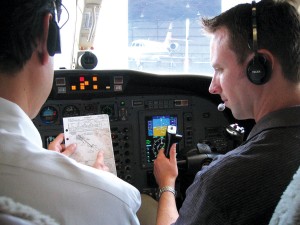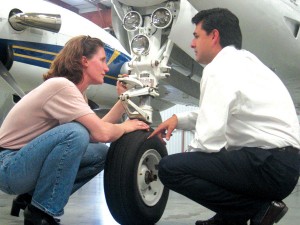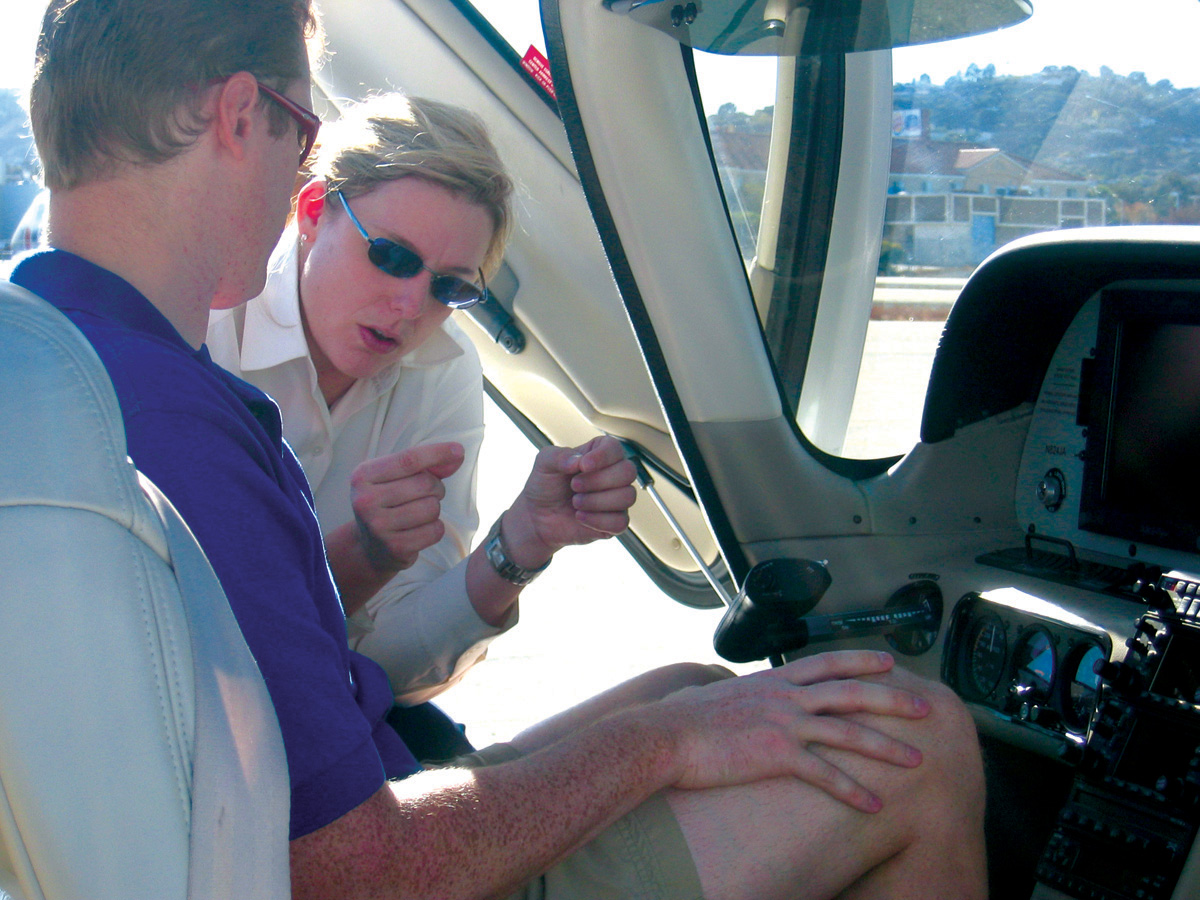By S. Clayton Moore
There are great pilots out there. There are also great flight instructors. Every once in a while, if you’re very lucky, you get both.

April D. Gafford, CEO and chief flight instructor at JATO Aviation, conducts cockpit familiarization in a Cirrus with one of the firm’s 30 current clients.
That rare combination is alive and well at JATO Aviation, based at San Carlos Airport (SQL) in San Carlos, Calif. This unusual organization combines dedicated pilot training and mentoring programs with a robust aviation consulting service. Focusing on technically advanced aircraft and very light jets, the company provides current and future pilots with the tools they need to be successful not only in learning how to fly but also in choosing the best aircraft and other equipment for their needs.
It’s still a small company, employing just seven flight instructors and a few administrative staff. But the pilots behind this visionary start-up thoroughly understand the general aviation market and know the direction they want to go as they build up the company. By offering training programs and other services that are tailored for each individual client, JATO Aviation lives up to the roots of its unusual name, granting each pilot their own “Jet-Assisted Take Off.”
“There are a few different parts to our business plan,” said CEO and chief pilot April Gafford. “The first part is to help people become proficient and safe pilots in technically advanced aircraft. The second part, which will evolve over the next few years, involves our mentoring pilots in very light jets.”
Gafford, a professional pilot and instructor who has been flying since 1990, has passion to spare when it comes to aviation. She was doing graduate work at San Jose State University in the late 1980s when one of her advisors at NASA Ames Research Center suggested she learn to fly. In 1990, she took her first lessons and it was a life-changing experience.
“The very first time I got in an airplane, I knew it was going to change everything,” she remembered. “I knew I didn’t want to just work with pilots. I wanted to be the pilot. I felt like I was finally in my element. Getting into that Cessna 152 felt like coming home.”
Gafford completed all her training and then did an internship with American Flyers in Santa Monica, Calif., where she completed all her type ratings. In 1999, she joined Diamond Aviation in San Carlos, where she still offers pilot services and instruction on an independent basis.
“I had never become a full-time corporate pilot because I love to teach too much,” she explained. “I get my fix from both.”
About two years ago, Gafford thoughtfully began noting the increase in pilots coming in with aircraft equipped with advanced GPS, autopilot and glass cockpits, as well as the burgeoning market in technically advanced aircraft.
“I thought it was really exciting,” she said. “When I started doing this type of training, I realized that we’re on the cusp of a revolution here in the general aviation environment. I thought this would be the perfect time to take advantage of it. I decided to start a company where we could do advanced pilot training in these technically advanced aircraft and glass cockpit aircraft.”
Gafford’s a gregarious character with close ties to many people and organizations in the California aviation community. Knowing she could bring in some of the best people she knew to help accomplish her vision, she founded JATO Aviation last year.
“I have a number of people I work with who are fabulous flight instructors, too,” she said. “I thought that if I started this company it could be an amazing place for like minds to come together and do the best job we could in teaching people how to fly.”
Teaching is something that speaks to Gafford’s soul as much, or more, than being behind the stick herself.
“The first thing I love about teaching is facilitating that process where people are able to do something they’ve wanted to do their whole lives,” Gafford said. “It’s something where people find a lot of satisfaction, and I love being a part of it. I think having a teacher who lays a good foundation really lends itself to pilots having a great experience learning to fly.”

One of JATO Aviation’s seven certified flight instructors (right) reviews procedures with a student pilot prior to takeoff.
JATO’s training encompasses three core training programs. They include “Go Glass,” a comprehensive approach to learning the advanced Garmin1000 and Avidyne glass cockpit instrument panels; “Jet Prep,” which prepares potential pilots to step up to a jet aircraft; and “Pilot Plus,” a goal-motivated study of aviation aspects that are most important to a potential pilot. Although each component is customized for each pilot depending on their needs, it does depend on some fundamental concepts about teaching, especially when it comes to technically advanced aircraft.
“It’s not just stick-and-rudder skills,” Gafford explained. “It’s also system management and flight management skills that need to be included in the package. We think of prioritization in the past as being traditionally ‘aviate, navigate, communicate.’ We still teach those basics, but layered on top of that ideal are these concepts. We need to be able to teach pilots all of these skills.”
Another important aspect is instilling the need for standard operating procedures.
“I think there’s a reason why the accident rate is lower in commercial and corporate aviation, and one critical reason is that we all follow standard operating procedures,” Gafford said. “I think a good training organization can help the pilot come up with a set of standard procedures that will help them stay safe by keeping ahead of the aircraft.”
While she’s a fan of high technology, Gafford is also a student of the human condition. Over more than a decade of teaching, combined with her graduate study of “human factors,” Gafford has found that some pilots have come to rely too heavily on technology.
“Some pilots call the autopilot the ‘copilot,'” Gafford observed. “We don’t refer to it that way. We refer to the autopilot as the student pilot. It does a lot of great stuff, but every once in a while it does something you don’t expect, so you have to stay in front of that automation, too.”
To help groups of pilots mitigate the risk of having too much information at once, Gafford and senior instructor Peter King have developed a series of seminars on “Flying the Glass Cockpit.”
“There’s so much information being presented to the pilot that we need to take a look at how that affects risk management,” Gafford said. “That level of information sometimes makes people feel they can do things differently, such as raising their personal minimums. We want to take a look at whether that’s a prudent thing to do.”

A certified flight instructor with JATO Aviation (right) takes a client through a step-up course designed to fully explain the aircraft’s mechanics.
Having learned a good system of teaching from her years with Diamond Aviation, JATO’s CEO is now applying and adapting those concepts to best serve the company’s area of expertise. With the proliferation of very light jets from companies like Adam Aircraft, Lancair and Eclipse, Gafford is finding that there’s a whole range of customers in need of JATO Aviation’s specific training services.
“You really see the gamut of this population who are learning to fly advanced aircraft,” she said. “These airplanes go fast and they’re more a way to get from point A to point B for transportation. As a result, we’re seeing more pilots who aren’t in love with aviation, per se, but really need this aircraft as a tool. Some people don’t realize the amount of training it takes to get to the point of handling the aircraft and taking a very professional approach to it. The reality is that we’re going to have all of these guys flying these aircraft.”
To help those in the market for an airplane, JATO Aviation has also put together an extensive platform for guiding owner-pilots through the nebulous world of aircraft acquisitions, retrofits and insurance negotiations.
“Too often, people don’t know how to go through this process because they’re not professional aviators,” Gafford explained. “Honestly, I’ve unfortunately seen a lot of guys get batted around like a pinball when they’re buying an airplane. They’re fielding pitches from every angle and they don’t know where to go for genuine help. That’s why we’re here to help streamline the process and help guide them where they need to go.”

JATO’s logo is boldly emblazoned on a Cirrus SR20 it maintains at its facilities at San Carlos Airport (SQL).
JATO offers a whole range of assistance, from choosing an aircraft to selecting avionics and insurance, all based on the specific needs of each customer.
“I get the question all the time: Is the G1000 or the Avidyne a better glass cockpit?” Gafford said. “There’s not one right answer. We have to sit down with each pilot and find out his ultimate goal and put him through a step-up program that is right for him. If that pilot wants to get into a Citation Mustang with a G1000, we want to put him through a set of airplanes with a G1000 in them. If the pilot wants to get into an Eclipse, we want a program that has a Cirrus in it. We’re going to look at that end goal and help them come up with a program to get them there more efficiently.”
To prepare themselves for this new wave of customers, Gafford and her staff have spent time trying to become as familiar with each different flavor of technically advanced aircraft as possible. At the same time, JATO’s goal is to augment the manufacturers’ training programs, not replace them.
“I’ve been through a couple of type-rating programs and even as a professional pilot, I felt like I was drinking from a fire hose,” Gafford said. “We want to get people ready by taking them through training that steps them into higher-performance aircraft. It’s something of a jet prep program. By the time they get to the type-rating programs, they know how these engines work and can better concentrate on the systems of that particular aircraft.”
That doesn’t mean that JATO’s services are no longer needed simply because a pilot has achieved his ratings. The company also offers aircraft management and pilot services for those owner-operators who still want a steady hand helping them in the hangar and beside them in the cockpit.
“Our goal is to help be their mentor pilots after they go through their official training,” Gafford said. “A lot of these guys are going to want a professional pilot sitting next to them for a while and so are the insurance companies. The bottom line is that these are busy, successful people and they need help to guide them through this world so they can be more efficient with their time.”
For more experienced pilots, JATO Aviation will also help to decide on more advanced equipment or other improvements for an existing aircraft.
“If they want to retrofit their airplane, we’ll talk to them about their mission and make sure we get the right set of avionics in there for them,” Gafford said. “There are lots of compatibility issues with retrofits, so we’ll guide them through choosing the right components that work well together.”
To help facilitate a pilot’s path into general aviation, JATO Aviation has built up partnerships with a number of flight schools, airplane dealers and maintenance facilities throughout Northern California.
“We have privileges at all the major airports in the Bay Area,” Gafford said. “We also get referrals from the sales staff of different manufacturers. When somebody sells an aircraft or an avionics package, they want to know they can recommend someone who will give their client professional training and is really going to help them out.”
Although the company maintains a Cirrus SR20 at Diamond Aviation for training purposes, the instructors prefer to mentor their clients in their own aircraft.
“Depending on the client and their goals, different facilities and airplanes will be more appropriate,” Gafford said. “If a pilot doesn’t yet own their own aircraft, or only wants to rent for now, we bring them to the flight school that has the best resources for them. Our model isn’t that of a traditional flight school in that we’re not looking to own a fleet of aircraft. We simply guide our clients to the places that are best for their needs.”
JATO is currently looking into leasing its own space, likely at San Carlos Airport, although its instructors are always willing to travel to a client’s location. The company is currently assisting more than 30 clients but is willing to increase its resources depending on its traffic.
“We’re expanding rapidly, but not too fast,” Gafford said. “We want to maintain the quality and the standardization in what we’re doing, at a high level. But, we can take on as many clients that want to use our services. We have a number of certified flight instructors and other personnel who would like to be involved, so if we have the clientele to merit hiring them, we’ll certainly do so.”
In the meantime, Gafford and her staff at JATO Aviation are simply enjoying the joys of flight and taking pleasure in teaching their customers.
“This is guidance and mentoring brought together to help people go to one company and have us guide them through the process, instead of relying on a variety of sources,” Gafford said. “When you’re ready, we’re here, at your service.”
For more information about JATO Aviation, call 1-866.FLY.JATO, email info@jatoaviation.com or visit [http://www.jatoaviation.com].












